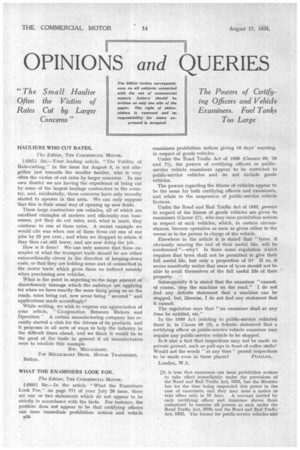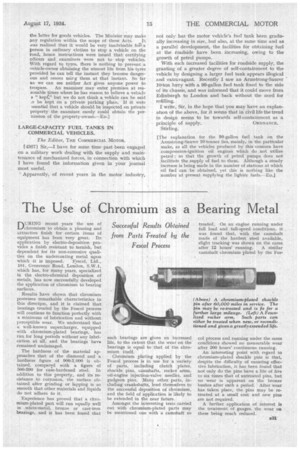OPINIONS and QUERIES
Page 44

Page 45

If you've noticed an error in this article please click here to report it so we can fix it.
HAULIERS WHO CUT RATES.
The Editor,_ TIIE COMMERCIAL MOTOR.
[4305] Sir,—Your leading article, "The Futility of Rate-cutting," in the issue for August 3, is not altogether just towards the smaller haulier, who is very often the victim of cut rates by larger concerns. In our own district we are having the experience of being cut by some of the largest haulage contractors in the country, and, incidentally, these concerns have only recently started to operate in this area. We can only suppose that this is their usual way of opening up new fields.
These large contractors use vehicles, all of which are excellent examples of modern and efficiently mu businesses, yet they do cut rates, and, what is more, they continue to run at these rates. A recent example we would cite was when one of these firms cut one of our jobs by 25 per cent., and when we dropped to retain it they then cut still lower, and are now doing the job.
How is it done? We can only assume that these examples of what the transport trade should be are either extraordinarily clever in the direction of keeping-down costs, or that they are holding some sort of connectimi in the motor trade whicii.giVes them an indirect subsidy when purchasing new vehicles. , What is the point in objecting,to:the large amount of discretienary tonnage whichtherailways are applying for when we have exactly the same thing going on on the roads, rates being cut, new areas being " secured " and applications made accordingly?
While writing, we wish to express our appreciation of your article, "Co-operation Between Makers and Operators." A certain manufacturing company has recently started a club for the drivers of its products, and it proposes in all sorts of ways to help the industry in the difficult times ahead, and we think it would be to the good of the trade in general if all manufacturers were to emulate this example.
Bw. MILLicnAmr, For MILLICHAMP BROS. MOTOR TRANSPORT. Belton.
WHAT THE EXAMINERS LOOK FOR.
The Editor, THE COMMERCIAL MOTOR.
[4366] Sir.—In the article "What the Examiners Look For," on page 771 of your July 20 issue, there are one or two statements which do not appear to be strictly in accordance with the facts. For instance, the position does not appear to be that certifying officers can issue immediate prohibition notices and vehicle 1330
exarainers prohibition notices giving 10 days' warning, in respect of goods vehicles.
Under the Road Traffic Act of 1990 (Clauses 69, 70 and 71), the powers of certifying officers or publicservice vehicle examiners appear to be restricted to public-service vehicles and do not include goods vehicles.
The powers regarding the fitness of vehicles appear to be the same for both certifying officers and examiners, and relate to the suspension of public-service vehicle licences.
Under the Road and Rail Traffic Act of 1933, powers in respect of the fitness of goods vehicles are given to examiners (Clause 17), who may issue prohibition notices in respect oi such vehicles, which, in certain circumstances, become operative as soon as given either to the owner or to the person in charge of the vehicle.
Elsewhere in the article it is stated that "tyres, if obviously nearing the end of their useful life, will be condemned "—why? Is there some regulation which requires that tyres shall not be permitted to give their full ,useful life, but only a proportion of it? If so, it seems manifestly unfair that users of tyres should not be able to avail themselves of the full useful life of their property.
Subsequently it is stated that the examiner "cannot, of course, stop the machine on the road." I do not find any, definite statement that a machine can be stopped, but, likewise, I do not find any statement that it cannot.
The regulation says that "an examiner shall at any time be entitled, etc."
In the 1930 Act (relating to public-service vehicles) there is, in Clause 69 (3), a definite statement that a certifying officer or public-service vehicle examiner may require any public-service vehicle to be stopped.
Is it also a fact that inspections may not be made on private ground, such as pull-ups in front of coffee sballs? Would not the words "at any time" permit inspections to be made even in these places? PUZZLED.
London, W.2,
[It is true that examiners can issue prohibition notices to take effect immediately under the provisions of the Road and Rail Traffic Act, 1983, but the Minister has for the time being suspended this power in the case of examiners, and they may issue a notice to take effect only in 10 days. A warrant carried by each "certifying officer and examiner shows them authorized to exercise all powers as such under the Road Traffic Act, 1930, and the Road and Rail Traffic Act, 1933. The former for public-senrice vehicles and
the latter for goods vehicles. The Minister may make
any regulation within the scope of these Acts. It was realized that it would be very inadvisable fat a person in ordinary clothes to stop a vehicle on the road, hence instructions were issued that certifying officers and examiners were not to stop vehicles. With regard to tyres, there is nothing to prevent a %7ehicle-owner obtaining the utmost life from his-tyres provided he can tell the instant they become dangerous and ceases usirg them at that instant. So far as we can see neither Act gives anyone power to trespass. An examiner may enter premises at reasonable times where he has reason to believe a vehicle s "kept" but we do not think a vehicle can he said ,o be kept on a private parking place. If it were !ssential that a vehicle should be inspected on private property the examiner, surely could obtain the pernission of the property-owner.--ED.]
LARGE-CAPACITY FUEL TANKS IN COMMERCIAL VEHICLES.
The Editor, THE COMMERCIAL MOTOR.
[4367] Sir,—I have for some time past been engaged on a military work dealing with the supply and maintenance of mechanized forces, in connection with which I have found the information given in your journal most useful.
Apparently, of recent years in the motor industry,
not only has the motor vehicle's fuel tank been gradually increasing in size, but also, at the Caine time and as a parallel development, the facilities for obtaining fuel at the roadside have been increasing, owing to the growth of petrol Pumps.
With such increased facilities for roadside supply, the granting of a greater degree of self-containment to the vehicle by designing a larger fuel tank appears illogical and extravagant. Recently I saw an Armstrong-Saurer 10-ton lorry with a 99-gallon fuel tank fixed to the side of its chassis, and was informed that it could move from Edinburgh to London and back without the need for refilling.
I write, Sir, in the hope that you may have an explanation of the above, for it seems that in civil life the trend in design seems to be towards self-containment as a principle of Supply. ORDNANCE. Stirling.
[The explanation for the 99-gallon fuel tank on the Armstrong-Saurer 10-tonner lies, mainly, in the particular make, as all the vehicles produced by this concern have compression-ignition oil enginea which do not utilize petrol ; so that the growth of petrol pumps does not facilitate the supply of fuel to them. Although a steady increase is being made in the number of stations at which oil fuel can be obtained, yet this is nothing like the number at present supplying the lighter fuels.—ED.]




























































































